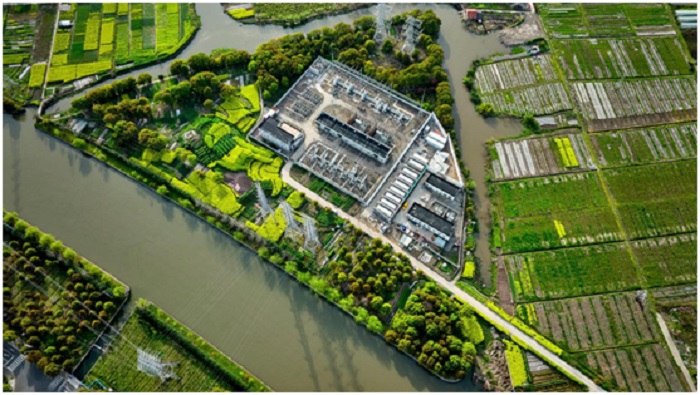



A compressed air energy storage project in Jintan district, Changzhou city, east China’s Jiangsu province, has turned a salt cavern located at 1,000 kilometers underground into a giant “power bank” that can store 300,000 kWh of electricity in an energy storage cycle, which is equivalent to the amount of electricity consumed by 60,000 residents a day.
The project uses electric energy to compress air into the salt cavern during off-peak hours, and releases the compressed air to drive turbo-expander for power generation when demand for electricity increases.
The above-mentioned compressed air energy storage method is one of the new ways to store energy, which refers to energy storage means except for pumped hydro energy storage, including energy storage systems using lithium-ion battery, flow battery, flywheel, compressed air, hydrogen (ammonia), and thermal (cold) energy storage technologies.
An energy storage facility can be considered as a giant “power bank” that is loaded with electricity during times of optimal wind and solar conditions or low demand for electricity and deliver electricity to a power grid during times of low power output from wind turbines and solar panels or high demand for electricity.
Such “power banks” can not only complement unstable photovoltaic and wind power generation and increase the proportion of renewable energy sources in power generation projects, but also improve the flexibility of electric power systems by helping with frequency regulation and peak shaving in coordination with fossil fuel power plant, nuclear power plant, or other types of power plants using conventional energy sources.
Besides, new-type energy storage facilities, which feature short construction period, simple and flexible site selection and strong regulation ability, can well suit the needs of new energy development and utilization projects.
China aims to steer new types of energy storage from the initial stage of commercialization to a stage of large-scale development by 2025, when the country will be able to carry out large-scale commercial application of relevant technologies, according to a recent plan on the development of new types of energy storage during China’s 14th Five-Year Plan period (2021-2025) released by Chinese authorities.
While new-type energy storage facilities mainly helped with frequency regulation as auxiliaries of fossil fuel power plants in the past, they will play an independent role in the market, as the plan pointed out.
The country will promote the market-oriented and orderly development of new types of energy storage and give full play to the decisive role of market in resource allocation, said the document.
“After their independent role in the market is recognized, new-type energy storage facilities will be able to independently take part in activities including connection to power grid, distribution of power, and settlement of transaction along with the introduction of electricity price policies, which will help accelerate their marketization process,” said Chen Yongchong, head of the energy storage technology research team of the Institute of Electrical Engineering under Chinese Academy of Sciences.
Safety is considered the bottom line in the development of new types of energy storage in China. The country will strengthen prevention of safety risks in the development of new types of energy storage, define clearly the responsibilities of various parties for ensuring the safety of various links of the industrial chain, establish and improve technical standards and systems for management, monitoring, and evaluation for the field, in a bid to guarantee the safety of the construction and operation of new-type energy storage projects, according to the plan.
Diversified technological routes are expected to be taken in the development of new types of energy storage in the country.
“Currently, lithium-ion battery is the most popular choice among all energy storage technologies. It is adopted by more than 80 percent of the new-type energy storage projects under construction, while other technologies, such as flow battery, lead-acid battery, and thermal (cold) energy storage, are far less used,” said Chen.
Energy storage enjoys rich application scenarios, according to Chen, who explained that each application scenario has different requirements for the performance of facility; some scenarios have high requirements for power, while others require great capacity.
Energy storage technologies have their own characteristics, he said, adding that various energy storage paths will develop in parallel.
While putting forward direction for the research and development of energy storage technologies, the plan encouraged different technological routes to “bloom at the same time” and stressed the importance of optimizing the allocation of innovation resources.
Since the beginning of the 13th Five-Year Plan period (2016-2020), new types of energy storage have realized the transition from the stage of research, development and demonstration to the initial stage of commercialization, achieving substantial progress.
The country is among the world’s leaders in energy storage technologies including lithium-ion battery and compressed air technologies. Its total installed capacity of new types of energy storage had surpassed four million kW by the end of 2021.
However, although the country has the largest installed capacity of energy storage in the world, its ratio of installed capacity of energy storage to installed capacity of wind power and photovoltaic power generation projects is less than 7 percent, far from close to the average level of 15.8 percent of other countries and regions.
As China is witnessing a rapid increase in the amount of electricity generated from new energy sources, it’s believed that the ratio will see significant growth in the country.


The Executive and members of the.


The Acting Director, FCT Directorate of.


President Bola Ahmed Tinubu has been.



Barely a month after resignation of.


An Abuja based Legal Practitioner, Osuagwu.



Convener of Equitable Remedy, Mrs. Magaret.


Contractors handling the contract for city.


Nigerian government may have concluded plans.


The Diplomatic Correspondents Association of Nigeria.


A rights group, “Follow Me Talk.
Leave a Comment